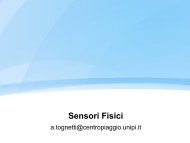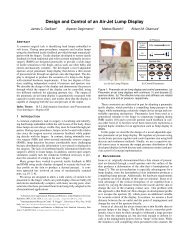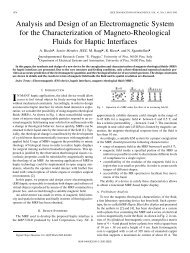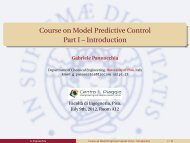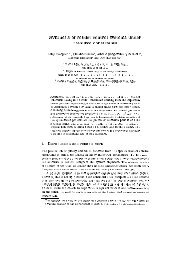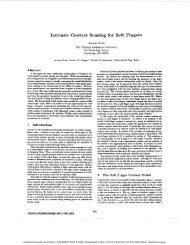Synergyâbased Optimal Design of Hand Pose ... - Centro E Piaggio
Synergyâbased Optimal Design of Hand Pose ... - Centro E Piaggio
Synergyâbased Optimal Design of Hand Pose ... - Centro E Piaggio
You also want an ePaper? Increase the reach of your titles
YUMPU automatically turns print PDFs into web optimized ePapers that Google loves.
Synergy–based <strong>Optimal</strong> <strong>Design</strong> <strong>of</strong> <strong>Hand</strong> <strong>Pose</strong> SensingMatteo Bianchi ∗ , Paolo Salaris ∗ and Antonio Bicchi ∗‡Abstract— This paper investigates the optimal design <strong>of</strong> lowcostgloves for hand pose sensing. This problem becomes particularlyrelevant when limits on the production costs <strong>of</strong> sensinggloves are taken into account. These cost constraints may limitboth the number and the quality <strong>of</strong> sensors used as well as thetechnology adopted. For this reason, an optimal distribution <strong>of</strong>sensors on the glove during the design phase is mandatory inorder to obtain good hand pose reconstruction. In this paper,by exploiting the knowledge on how humans most frequentlyuse their hands in grasping tasks, we study the problem <strong>of</strong>how and where to place sensors on the glove in order to getthe maximum information about the actual hand posture, andhence minimize in average the reconstruction error. Simulationsand experiments <strong>of</strong> reconstruction performance are reported tovalidate the proposed optimal design <strong>of</strong> sensing devices.I. INTRODUCTIONIn recent years numerous studies have underlined thecomplex role <strong>of</strong> human hand in motor organization, withparticular attention to grasping tasks. It was shown that individuatedfinger motions were phylogenetically superimposedon basic grasping movements [1]. Moreover, it is possibleto individuate a reduced number <strong>of</strong> coordination patterns(synergies) which constrain both joint motions and forceexertions <strong>of</strong> multiple fingers [2]. Coordination patterns wereanalyzed by means <strong>of</strong> multivariate statistical methods overa grasping dataset, revealing that a limited amount <strong>of</strong> socalledeigenpostures or principal components (PCs) [3], [4],or otherwise statistically identified kinematic coordinationpatterns [2], are sufficient to explain a great part <strong>of</strong> handpose variability.In [5] we have exploited the knowledge on how humansmost frequently use their hands (a priori information) forhand pose reconstructions from measures provided by givenlow–cost sensing “gloves”, i.e. devices for hand pose reconstructionbased on measurements <strong>of</strong> few geometric features<strong>of</strong> the hand. In this manner final results are improved inspite <strong>of</strong> insufficient and inaccurate sensing data. Glove–basedsystems represent the most popular devices for gesture measurement,providing useful interfaces for human–machineand haptic interaction in many fields like, for example, virtualreality, musical performance, video games, teleoperation androbotics [6]. In this paper, we extend the analysis in [5]including the optimal design <strong>of</strong> these devices. The aim isto find, for a given a priori information, the optimal sensordistribution that minimizes the reconstruction error in aminimum variance sense. This problem becomes particularlyThis work is supported by the European Commission under CP grantno. 248587, THE <strong>Hand</strong> Embodied, within the FP7-ICT-2009-4-2-1 programCognitive Systems and Robotics.∗ Interdept. Research Center “Enrico <strong>Piaggio</strong>”, University <strong>of</strong> Pisa, Italy.m.bianchi,p.salaris,bicchi@centropiaggio.unipi.it,‡ Department <strong>of</strong> Advanced Robotics, Istituto Italiano di Tecnologia, viaMorego, 30, 16163 Genova, Italy.relevant when limits on the production costs <strong>of</strong> sensinggloves are taken into account. These cost constraints maylimit both the number and the quality <strong>of</strong> sensors used, andhence an optimal distribution <strong>of</strong> sensors during the designphase is mandatory in order to achieve good performance.Notice that this optimization procedure is strictly related tothe reconstruction algorithm described in [5]. Indeed, thepose reconstruction obtained using optimal sensor design isactually optimal only if reconstruction approaches describedin [5] are used.The problem <strong>of</strong> optimal design <strong>of</strong> pose sensing gloveshas already been investigated, e.g. in [7], [8], [9], [10]. Forinstance, in [10] authors explore how to methodically selecta minimal set <strong>of</strong> hand pose features from optical marker datafor grasp recognition. The objective is to determine markerlocations on the hand surface that is appropriate for graspclassification <strong>of</strong> hand poses. However, all the aforementionedapproaches rely on experimental observations: from actualsensor data, locations that provide the largest and most usefulinformation on the system are chosen.In this paper we investigate a similar problem, obtainingthe optimal distribution <strong>of</strong> sensors able to minimize inaverage the reconstruction error <strong>of</strong> hand poses, and hencemaximizing the information on the real hand posture availableby the glove in a minimum variance sense. Moreover,by optimizing the number and location <strong>of</strong> sensors the cost <strong>of</strong>production and the calibration time can be further reducedwithout loss <strong>of</strong> performance, thus enabling for device diffusion.We first consider the continuous sensing case, whereindividual sensing elements in the glove can be designedso as to measure a linear combination <strong>of</strong> joint angles. Anexample <strong>of</strong> this type <strong>of</strong> device is the sensorized glovedeveloped in [11] or the 5DT Data Glove (5DT Inc., Irvine,CA, USA). However, depending on the sensing technologyadopted for the glove design, the implementation <strong>of</strong> thecontinuous sensing can be difficult and/or costly. For thisreason, we then consider the discrete sensing case, whereeach measure provided by the glove corresponds to a singlejoint angle. An example <strong>of</strong> this type <strong>of</strong> glove is the Humanglove(Humanware s.r.l., Pisa, Italy) or the Cyberglove(CyberGlove Systems LLC, San Jose, CA, USA). Finally, inorder to take advantage from both continuous and discretesensing — the amount <strong>of</strong> information achievable vs low-costimplementation and feasibility — we also provide an optimaldesign <strong>of</strong> hybrid sensing devices characterized by both types<strong>of</strong> sensors.Experiments and statistical analyses demonstrate the improvement<strong>of</strong> the estimation techniques proposed in [5] byusing the optimal design described in this paper.The here discussed results can be used to enable for amore effective development <strong>of</strong> both sensorization systems
gradient flow (10) onto the subspace tangent to the constraint,obtaining the search directions = ∇‖P p ‖ 2 FW . (11)Having the search direction for the constrained problem,the gradient flow is given byḢ = −4 [ P 2 pP o H T Σ(H) ] TW (12)where Σ(H) = (HP o H T +R) −1 . The gradient flow (10) guaranteesthat the optimal solution H ∗ has unit vectors as rows,if H(0) satisfies the latter condition.In [15] authors define a function V 2 (P) with P ∈ IR n×nthat forces the entries <strong>of</strong> P to be as “positive” as possible.In this section, for the second gradient, we extend thisfunction to measurement matrices H ∈ IR m×n with m < n,thus considering function V 2 : O m×n → IR, given byV 2 (H) = 2 3 tr[ H T (H − (H ◦ H)) ] , (13)where A ◦ B denotes the Hadamard or elementwise product<strong>of</strong> the matrices A = (a i j ) and B = (b i j ), i.e. A ◦ B = (a i j b i j ).The gradient flow <strong>of</strong> V 2 (H) isḢ = −H [ (H ◦ H) T H − H T (H ◦ H) ] , (14)which minimizes V 2 (H) converging to a matrix in P m×n ifH(0) ∈ O m×n (H(0) is the starting point at t = 0 for (14)).By combining (12) and (14), we can build the followinggradient flowḢ c,d = 4(1 − k) [ P 2 pP o H T c,d Σ(H c,d) ] TW++ k ¯H d[( ¯H d ◦ ¯H d ) T ¯H d − ¯H T d ( ¯H d ◦ ¯H d ) ] , (15)where k ∈ [0, 1] is a positive constant, Σ(H c,d ) =(H c,d P o Hc,d T + R)−1 , W = I n − Hc,d T (H c,dHc,d T )−1 H c,d is theprojecting matrix onto the set <strong>of</strong> all matrices whose rows areunit vectors, and, finally, ¯H d assumed the following form:[ ]0mc ×n¯H d = .H dThe gradient flow defined in (15) converges towards ahybrid sensing device, i.e. with both continuous and discretesensors, if H c,d (0) ∈ O m×n , minimizing the squaredFrobenius norm <strong>of</strong> the a posteriori covariance matrix. Noticethat, since this problem is not convex, we can only assurethat the proposed algorithm converges to a local minimum.To overcome this common problem in gradient methods aclassic solution can be provided by performing a multi–startsearch.IV. RESULTSFigure 1 shows the values <strong>of</strong> the squared norm <strong>of</strong> thea posteriori covariance matrix for increasing number m <strong>of</strong>measures. In particular, values <strong>of</strong> V 1 for matrices Hc ∗ and Hd∗are reported, for both noise–free and noisy measures. Noticethat, in case <strong>of</strong> noise–free measures, V 1 values decreasewith the number <strong>of</strong> measures, tending to assume nearlyzero values in case <strong>of</strong> both continuous and discrete sensing.This fact is trivial because increasing the measurements wereduce the uncertainty <strong>of</strong> the measured variables. When allV 1(P o,H,R)0.140.120.10.080.060.040.02H * c , R=0H d* , R=0H c* , R≠ 0H d* , R≠ 001 2 3 4 5 6 7 8 9 10 11 12 13 14mFig. 1: Squared Frobenius norm <strong>of</strong> the a posteriori matrixwith noise–free and noisy measures (with noise covariancematrix R = diag(12) [ ◦ ]) for both H ∗ c and H ∗ d .the measured information is available V 1 assumes zero valuewith perfectly accurate measures. In case <strong>of</strong> noisy measures,V 1 values decrease with the number <strong>of</strong> measures but, in thiscase, it tends to a value which is larger, depending on thelevel <strong>of</strong> noise.In case <strong>of</strong> free-noise measures, if we analyze how muchV 1 reduces with the number <strong>of</strong> measurements w.r.t. the valueit assumes for only one measure, reduction percentage withthree measures is greater than 80% for both H ∗ c and H ∗ d .This result suggests that with only three measurements theoptimal matrix can furnish more than 80% <strong>of</strong> uncertaintyreduction. This is equivalent to say that a reduced number <strong>of</strong>measurements is sufficient to guarantee a good hand postureestimation. In [4], [13], under the controllability point <strong>of</strong>view, authors state that three postural synergies are crucial ingrasp pre–shaping as well as in grasping force optimizationsince they take into account for more than 80% <strong>of</strong> variance ingrasp poses. Here, the same result can be obtained in terms<strong>of</strong> the measurement process, i.e. from the observability point<strong>of</strong> view: a reduced number <strong>of</strong> measures coinciding with thefirst three principal components enables for more than 80%reduction <strong>of</strong> the squared Frobenius norm <strong>of</strong> the a posterioricovariance matrix.V. EXPERIMENTSIn this work, we deal with the problem <strong>of</strong> hand posereconstructions considering noisy measures in the discretesensing case. We consider an additional zero–mean randomGaussian noise with standard deviation <strong>of</strong> 7 ◦ on each measureand hence a noise covariance matrix R = diag(7) [ ◦ ].This value is chosen in a cautionary manner, based on dataabout common technologies and tools used to measure handjoint positions [17]. Without loss <strong>of</strong> generality we haveadopted the 15 DoF model also in used [4], [13], [5] andreported in figure 3. As described in [5], an optical motioncapture system (Phase Space, San Leandro, CA - USA)with 19 active markers is used to collect a large number <strong>of</strong>static grasp positions, see figure 4. Subject AT (M,26) hasperformed all the grasps <strong>of</strong> the 57 imagined objects describedin [4]; these data have been acquired twice to define a set <strong>of</strong>114 a priori data.
Real <strong>Hand</strong> PosturesPosture estimations with noisy measuresMVE with Hse i 7.28 ◦ 7.86 ◦ 7.34 ◦ 8.47 ◦MVE with H ∗ de i 6.47 ◦ 4.28 ◦ 5.38 ◦ 7.59 ◦Fig. 8: <strong>Hand</strong> pose reconstructions by MVE algorithm as described in section II by using matrix H s which allows to measureT M, IM, MM, RM and LM and matrix Hd ∗ which allows to measure TA, MM, MP, LP and LM (cf. figure 3). In color thereal hand posture whereas in white the estimated one. The pose error is given by e i =n 1 ∑n i=1 |x i − ˆx i |.REFERENCES[1] A. Gordon, <strong>Hand</strong>book <strong>of</strong> Brain and Behaviour in Human Development.The Netherlands: Kluwer Academic, 2001, ch. Development<strong>of</strong> hand motor control, pp. 513 – 537.[2] M. H. Schieber and M. Santello, “<strong>Hand</strong> function: peripheral andcentral constraints on performance,” Journal <strong>of</strong> Applied Physiology,vol. 96, no. 6, pp. 2293 – 2300, 2004.[3] C. R. Mason, J. E. Gomez, and T. J. Ebner, “<strong>Hand</strong> synergies duringreach-to-grasp,” J Neurophysiol, vol. 86, pp. 2896 – 2910, 2001.[4] M. Santello, M. Flanders, and J. F. Soechting, “Postural hand synergiesfor tool use,” The Journal <strong>of</strong> Neuroscience, vol. 18, no. 23, pp. 10 105– 10 115, 1998.[5] M. Bianchi, P. Salaris, A. Turco, N. Carbonaro, and A. Bicchi, “On theuse <strong>of</strong> postural synergies to improve human hand pose reconstruction,”in IEEE Haptics Symposium, 2012, pp. 91 – 98.[6] L. Dipietro, A. Sabatini, and P. Dario, “A survey <strong>of</strong> glove-basedsystems and their applications,” Systems, Man, and Cybernetics, PartC: Applications and Reviews, IEEE Transactions on, vol. 38, no. 4,pp. 461 –482, 2008.[7] D. J. Sturman and D. Zeltzer, “A design method for “whole-hand”human-computer interaction,” ACM Trans. Inf. Syst., vol. 11, no. 3,pp. 219–238, 1993.[8] J. Edmison, M. Jones, Z. Nakad, and T. Martin, “Using piezoelectricmaterials for wearable electronic textiles,” in Wearable Computers,2002. (ISWC 2002). Proceedings. Sixth International Symposium on,2002, pp. 41 – 48.[9] F. Vecchi, S. Micera, F. Zaccone, M. C. Carrozza, M. Sabatini, andP. Dario, “A sensorized glove for applications in biomechanics andmotor control,” in Annu. Conf. Int. Functional Electr. Simulation Soc.,2001.[10] L. Y. Chang, N. S. Pollard, T. M. Mitchell, and E. P. Xing, “Featureselection for grasp recognition from optical markers,” in IntelligentRobots and Systems, 2007. IROS 2007. IEEE/RSJ International Conferenceon, 2007, pp. 2944–2950.[11] A. Tognetti, N. Carbonaro, G. Zupone, and D. De Rossi, “Characterization<strong>of</strong> a novel data glove based on textile integrated sensors,” inAnnual International Conference <strong>of</strong> the IEEE Engineering in Medicineand Biology Society, EMBC06, Proceedings., 2006, pp. 2510 – 2513.[12] C. R. Rao, “The use and interpretation <strong>of</strong> principal component analysisin applied research,” The Indian journal <strong>of</strong> statistic, 1964.[13] M. Gabiccini and A. Bicchi, “On the role <strong>of</strong> hand synergies in theoptimal choice <strong>of</strong> grasping forces,” in Robotics Science and Systems,2010.[14] K. Diamantaras and K. Hornik, “Noisy principal component analysis,”Measurement‘93, pp. 25 – 33, 1993.[15] M. M. Zavlanos and G. J. Pappas, “A dynamical systems approach toweighted graph matching,” Automatica, 2008.[16] J. B. Rosen, “The gradient projection method for nonlinear programming.part i. linear constraints,” Journal <strong>of</strong> the Society for Industrialand Applied Mathematics, vol. 8, no. 1, pp. 181 – 217, 1960.[17] L. K. Simone, N. Sundarrajan, X. Luo, Y. Jia, and D. G. Kamper, “Alow cost instrumented glove for extended monitoring and functionalhand assessment.” Journal <strong>of</strong> Neuroscience Methods, vol. 160, no. 2,pp. 335–348, 2007.[18] Q. Fu and M. Santello, “Tracking whole hand kinematics usingextended kalman filter,” in Engineering in Medicine and BiologySociety (EMBC), 2010 Annual International Conference <strong>of</strong> the IEEE,2010, pp. 4606 – 4609.[19] X. Zhang, S. Lee, and P. Braido, “Determining finger segmentalcenters <strong>of</strong> rotation in flexion-extension based on surface markermeasurement,” Journal <strong>of</strong> Biomechanics, vol. 36, pp. 1097 – 1102,2003.[20] A. Bicchi and G. Canepa, “<strong>Optimal</strong> design <strong>of</strong> multivariate sensors,”Measurement Science and Technology (Institute <strong>of</strong> Physics Journal“E”), vol. 5, pp. 319–332, 1994.




